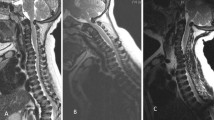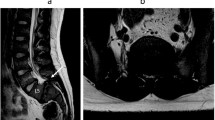Abstract
Mucopolysaccharidosis type IVA, also known as Morquio syndrome, is an autosomal recessive lysosomal storage disease. Skeletal dysplasia with short stature, dysplastic-hypoplastic dens (os odontoideum), ligamentous hyperlaxity, and C1-C2 instability are characteristic features. Most patients with Morquio syndrome present with compressive myelopathy at a young age as a result of a combination of C1-C2 instability and extradural soft tissue thickening; treatment generally consists of anterior decompression with occipito-cervical fusion and external orthosis. In this report, we describe the successful treatment of a young child using posterior C1-C2 fusion alone with a free-hand technique. A 3-year-old boy presented at our hospital with a 5-month history of progressive quadriparesis. A whole-body skeletal survey showed skeletal dysplasia with hypoplasia, thoracolumbar kyphosis, and atlantoaxial subluxation. Preoperative cervical imaging showed compressive myelopathy at C1-C2 and atlantoaxial subluxation. C1-C2 fixation and decompression were performed successfully. After the operation, the patient had improved strength and was able to walk independently 8 months postoperatively. Establishment of stability via C1-C2 fusion is challenging in patients with genetic disorders characterized by skeletal dysplasia because of these young patients’ small bone size and deficient bone quality. In this unique case, the treatment consisted solely of C1-C2 fusion with a free-hand technique. This case report presents a new approach in the treatment of atlantoaxial instability in Morquio syndrome.



Similar content being viewed by others
References
Rahimizadeh A, Yazdi T, Hamidifar M, Rahimizadeh A (2014) Atlantoaxial arthodesis using harms technique in a case of Morquio syndrome. World Spinal Column J 5:124–129
Brailsford JF (1976) Chondro-osteo-dystrophy: roentgenographic and clinical features of a child with dislocation of vertebrae. Clin Orthop Relat Res 114:4–9
Tomatsu S, Montano AM, Oikawa H et al (2011) Mucopolysaccharidosis type IVA (Morquio A disease): clinical review and current treatment. Curr Pharm Biotechnol 12(6):931–945
Visocchi M, Concezio Di Rocco. Os odontoideum syndrome: pathogenesis, clinical patterns and indication for surgical strategies in childhood. Pediatric craniovertebral junction disease pp273–293
Pouliquen JC, Pennecot GF, Geneux J, Chadoutaud F, Lacert P, Duval-Beaupere G, Durand J Craniovertbral junction and Morquio disease. Apropos of 6 cases. Chir Pediatr 23(4):247–255
Solanki GA, Martin KW, Theroux MC et al (2013) Spinal involvement in mucopolysaccharidosis IVA (Morquio-Brailsford or Morquio A syndrome): presentation, diagnosis and management. J Inherit Metab Dis 36(2):339–355
Ashraf J, Crokard HA, Ransford AO (1991) Transoral decompression and posterior stabilization in Morquio's disease. Arch Dis Child 66:1318–1132
Visocchi M, Della Pepa GM, Doglietto F, Esposito G, La Rocca G, Massimi L (2011) Video-assisted microsurgical transoral approach to the craniovertebral junction: personal experience in childhood. Childs Nerv Syst 27(5):825–831. https://doi.org/10.1007/s00381-010-1386-5
Visocchi M, Signorelli F, Liao C, Rigante M, Paludetti G, Barbagallo G, Olivi A (2017 May) Endoscopic endonasal approach for craniovertebral junction pathologic conditions: myth and truth in clinical series and personal experience. World Neurosurg 101:122–129. https://doi.org/10.1016/j.wneu.2017.01.099
Visocchi M, Fernandez E, Ciampini A, Di Rocco C (2009) Reducible and irreducible os odontoideum in childhood treated with posterior wiring, instrumentation and fusion. Past or present? Acta Neurochir (Wien) 151(10):1265–1274
Visocchi M, Pietrini D, Tufo T, Fernandez E, Di Rocco C (2009) Pre-operative irreducible C1-C2 dislocations: intra-operative reduction and posterior fixation. The “always posterior strategy”. Acta Neurochir (Wien) 151(5):551–559; discussion 560. https://doi.org/10.1007/s00701-009-0271-z
Kim JY, Oh CH, Yoon SH, Park HC, Seo HS (2014) Comparison of outcomes after atlantoaxial fusion with transarticular screws and screw-rod constructs. J Korean Neurosurg Soc 55(5):255–260
Williams N, Narducci A, Eastwood DM, Cleary M, Thompson D (2018) An evidence-based approach to the management of children with Morquio a syndrome presenting with craniocervical pathology. Spine (Phila Pa 1976) 43(24):E1443–E1453
Sitoula P, Mackenzie WG, Shah SA, Thacker M, Ditro C, Holmes L Jr, Campbell JW, Rogers KJ (2014) Occipitocervical fusion in skeletal dysplasia: a new surgical technique. Spine (Phila Pa 1976) 39(15):E912–E918
Ransford AO, Crockard HA, Stevens JM, Modaghegh S (1996) Occipito-atlanto-axial fusion in Morquio-Brailsford syndrome. A ten-year experience. J Bone Joint Surg Br 78(2):307–313
Vanek P, Homolkova H, Benes V, Zeman J (2015) Occipitocervical stabilization using bilateral laminar C2 screws in children with mucopolysaccharidosis IVA. Eur Spine J 24(12):2756–2762
Park JH, Roh SW, Rhim SC (2015) A single-stage posterior approach with open reduction and pedicle screw fixation in subaxial cervical facet dislocations. J Neurosurg Spine 23(1):35–41
Chon H, Park JH (2017) Cervical vertebral body fracture with ankylosing spondylitis treated with cervical pedicle screw: a fracture body overlapping reduction technique. J Clin Neurosci 41:150–153
Lee S, Seo J, Lee MK, Jeon SR, Roh SW, Rhim SC, Park JH (2017) Widening of the safe trajectory range during subaxial cervical pedicle screw placement: advantages of a curved pedicle probe and laterally located starting point without creating a funnel-shaped hole. J Neurosurg Spine. 27(2):150–157
Heo Y, Lee SB, Lee BJ et al (2019) The learning curve of subaxial cervical pedicle screw placement: how can we avoid neurovascular complications in the initial period? Oper Neurosurg (Hagerstown). https://doi.org/10.1093/ons/opz070
Lee S, Park JH (2019) Minimally invasive cervical pedicle screw placement with a free-hand technique through the posterolateral approach using a tubular retractor: a technical note. Oper Neurosurg (Hagerstown). https://doi.org/10.1093/ons/opy375
Park JH, Jeon SR, Roh SW, Kim JH, Rhim SC (2014) The safety and accuracy of free-hand pedicle screw placement in the subaxial cervical spine: a series of 45 consecutive patients. Spine (Phila Pa 1976) 39(4):280–285
Author information
Authors and Affiliations
Corresponding authors
Ethics declarations
Conflicts of interest
The authors declare no conflict of interest with respect to the materials or methods used in this study or the findings specified in this paper.
IRB approval
The study protocol was approved by the Institutional Review Board of Asan Medical Center (IRB No. 2019-0879).
Additional information
Publisher’s note
Springer Nature remains neutral with regard to jurisdictional claims in published maps and institutional affiliations.
Electronic supplementary material
Rights and permissions
About this article
Cite this article
Moon, E., Lee, S., Chong, S. et al. Atlantoaxial instability treated with free-hand C1-C2 fusion in a child with Morquio syndrome. Childs Nerv Syst 36, 1785–1789 (2020). https://doi.org/10.1007/s00381-020-04561-2
Received:
Accepted:
Published:
Issue Date:
DOI: https://doi.org/10.1007/s00381-020-04561-2




